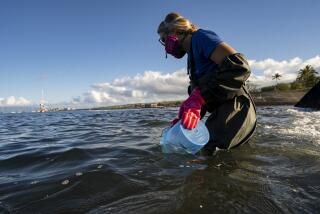Sri Lanka Coral Miners Devastate Coast
- Share via
HIKKADUWA, Sri Lanka — Entire reefs have disappeared along parts of this coastline in southern Sri Lanka, hacked away by generations of villagers who mine and burn coral to make lime for the construction industry.
Without the protecting arm of the reefs, large chunks of coastline, exposed to the lashing waves of the Indian Ocean in stormy weather, have been washed away.
Today, big boulders are piled along much of the coastline to prevent further sea erosion.
Coral mining has been banned and the lime kilns that once lined the road along the southern coast were destroyed about a year ago. But the problems remain.
“Illicit mining still continues, mostly at night, since the law is not enforced properly and the kilns have been moved inland,” said an official of the National Aquatic Resources Agency (NARA).
Surveys by NARA reveal a high percentage of dead coral along much of the island’s coastline. Along parts of the southern coast, as much as 80% of the coral is dead.
Coast conservation authorities say Sri Lanka loses about six feet of beach each year, although not all the erosion is due to coral mining; some areas are naturally devoid of reef cover.
Even the resort town of Hikkaduwa is estimated to have 25% dead coral in its marine sanctuary. Residents and environmentalists say the coral garden that made the town a major tourist attraction is threatened by neglect and mismanagement.
“Five or six years ago there was a carpet of blue coral,” said Shantha Delwita, a local resident and hotelier. “Today much of it is dead.”
Years of too many visitors, illicit coral collection and pollution from fishing boats and hotels that mushroomed along the beach have taken their toll on the marine sanctuary.
“The coral garden now is not what it used to be 20 years ago,” said Jagath Gunawardena, a conservationist at the Environmental Foundation Ltd., a private legal aid group based in Colombo, about 62 miles from Hikkaduwa.
“The authorities must now protect what remains,” Delwita said. He thinks the illicit coral collection and sale could be stopped if notices were put up around the resort in foreign languages asking tourists not to buy coral and outlining the environmental degradation at Hikkaduwa.
He also says glass-bottomed boats used for viewing the coral should be subject to controls and banned from dropping anchor over the coral garden.
NARA officials and conservationists say much of the damage to the reefs on the southern coast occurred in the last 10 to 15 years.
Although the lime industry, carried on by generations of coastal villagers, is the biggest threat to the reefs, coral is also destroyed by the use of dynamite for fishing.
Some of the villagers, thrown out of work by the coral mining ban and reluctant to take up the government’s offer of land for farming, survive on odd jobs or mine the reefs at night.
“The police can’t guard the reefs 24 hours a day,” said Wilson Mendis, who runs a kiln supplied with coral mined in licensed quarries inland. “Unless the government finds the miners jobs, how can they stop it?”
Other villagers join the human chains at the inland quarries to haul baskets of coral up the quarry face. But the inland quarries are themselves environmental hazards.
The wide, deep pits from which water has to be constantly pumped ruin arable land and are breeding grounds for mosquitoes, although the quarry supervisors contend they cover the holes once mining is over.
More to Read
Sign up for Essential California
The most important California stories and recommendations in your inbox every morning.
You may occasionally receive promotional content from the Los Angeles Times.













